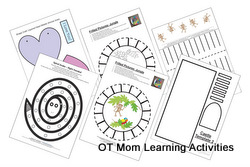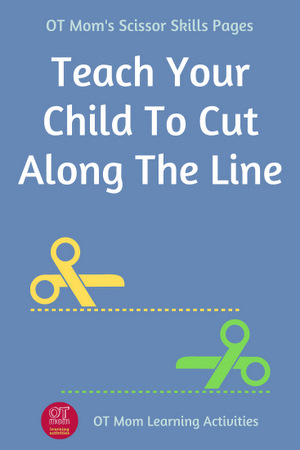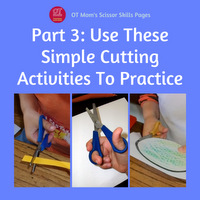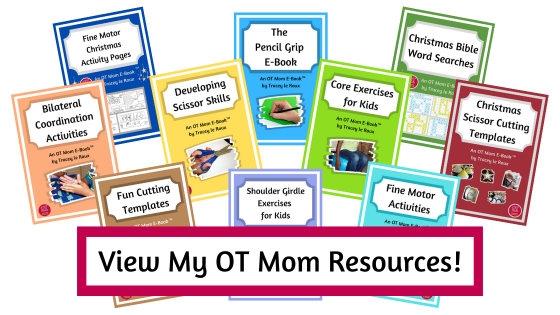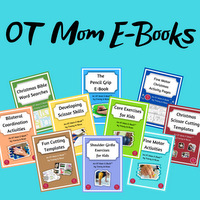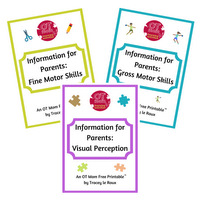- Home Page
- Scissor Cutting Skills
- Part 2: Teach Your Child To Cut Along A Line
Help Your Child Cut Along The Line
Learning to cut along the line is a tricky task.
It involves a lot of coordination between the hand holding the scissors and the hand holding the paper. In addition, your child needs to visually focus on the line in order to guide the hands, and also needs to plan how to get the scissors in and out of corners.
This is part two of my three-part series in helping preschoolers master scissor cutting skills!
- Part 1 (previous page) will help your child master the grasp-release motion of the scissors
- Part 2 (this page) will help your child master the art of cutting out along a line
- Part 3 (next page) will give your child lots of practice with simple cutting activities
If your child is struggling to cut along the line, then use the guidelines and activities on this page to help your child to master this important skill!
I sometimes link to products (#Ad) that are similar to those I use and love. If you do purchase something through my links, I will receive a small commission that helps support my site - thank you!
On this page:
Remember, if you are at all concerned about your child's scissor cutting skills, please do speak to an occupational therapist. This website is not a substitute for occupational therapy!

Tips To Cut Along The Line Properly
In order to cut along the line properly, your child needs to be able to hold and turn the paper effectively, in addition to being able to open and close the scissors!
Here are some tips that can help your child become more effective and efficient at staying on the line while cutting out:
Tip 1: Check the Position of the Paper
Encourage your child to hold the paper off the table with the assistant hand.
Thumb on top and fingers underneath is the best position for the assistant hand AND the cutting hand - ask your child to give you "two thumbs up!" before starting with the cutting task, as a reminder to keep the thumbs on top.
Discourage your child from holding the paper down on the table.
Kids with poor bilateral coordination often prefer to hold the paper down on the table, because the assistant hand can't coordinate properly with the cutting hand.
So try some simple, free bilateral coordination activities to help your child learn to use both hands well together.
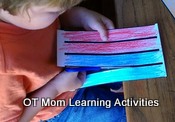 Hold the paper off the table
Hold the paper off the table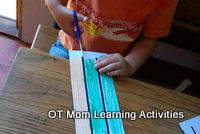 Don't hold the paper flat on the table
Don't hold the paper flat on the tableTip 2: Check Where Your Child Starts Cutting (And The Size Of The Paper)
Encourage your child to start cutting along the line furthest from the holding hand. This helps your child keep better control over what is being cut out.
Younger children often cope better with half sheets of paper - these are more manageable than full sized paper.
 Starting on the line farthest from the holding hand.
Starting on the line farthest from the holding hand.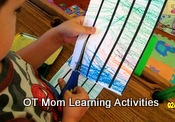 Discourage your child from starting close to the holding hand.
Discourage your child from starting close to the holding hand.Tip 3: Use Wider Lines and Thicker Paper For Beginners
I like to use thin cardstock when teaching kids to cut along the line. This is less floppy than normal paper and is easier for kids to handle. If you don't have thin cardstock, stick two regular sheets of paper together.
Wider lines can help young children to learn to cut along the line.
I like to tell them that the thick black line is a road and they need to drive the scissors along the road like a car. If they go off the road, they might knock down a pedestrian :-) .
As the child masters scissor cutting, you can use lines which are narrower, but the "driving the car" principle still applies!
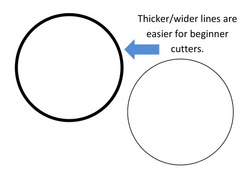 Wider lines are better for beginners
Wider lines are better for beginnersTip 4: Encourage Your Child To Cut Around Shapes The Correct Way
Cutting around shapes in the correct direction will help your child to get the blade of the scissors to stay on the line more effectively and should help your child to cut more smoothly.
Right-handers should cut to the right of the shape, and left-handers should cut to the left of the shape.
This enables them to more clearly see the blade to ensure they can cut along the line.
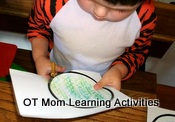 Correct - a right-hander cutting to the right of the circle
Correct - a right-hander cutting to the right of the circle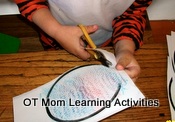 Incorrect - a right-hander cutting to the left of the circle
Incorrect - a right-hander cutting to the left of the circleLearning to Cut On Straight Lines
In the developmental progression of cutting skills, children need to first learn to cut along straight lines before progressing to cutting out simple shapes along a line.
Step 1: Cutting Short Straight Lines
Start by having your child cut or snip along very short lines, then progress to cutting along slightly longer lines.
The activities shown here can be found in my Fun Cutting Templates download, but it is really easy to just draw the short lines on a paper plate or scrap paper.
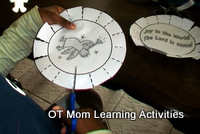 Snip along very short lines
Snip along very short lines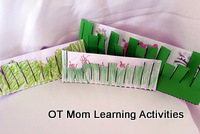 Cutting grass along short lines
Cutting grass along short linesStep 2: Cutting Long Straight Lines
When I am teaching a child to cut along the line, we practice over and over again with LOTS of lines. We use the lines to make all sorts of fun creations, like paper chains, a jellyfish, an octopus... view some ideas over at my cutting activities page.
You can color the lines in to make it more interesting, or have your child practice handwriting patterns on the lines before cutting out, as shown here.
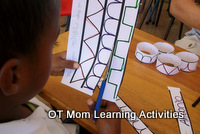 Decorate the lines before cutting them out!
Decorate the lines before cutting them out!Step 3: Cut Lots of Circles and Spirals
Cutting out lots of circles and spirals will help your child to get the hang of smoothly moving the paper with the assistant hand while cutting.
(Spiral snakes like this one are part of my fun cutting practice printables!)
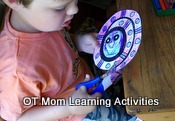 Cutting along the line on a spiral snake
Cutting along the line on a spiral snakeRemember, right-handers should cut to the right of the circle, and left-handers should cut to the left of the circle.
I find it really helps to sit behind the child and hand-over-hand help them to get the feel of the smooth movement of turning the paper around while cutting along the line.
Step 4: Progress To Simple Shapes
Once your child has got the hang of turning the paper while cutting, then progress to cutting out on the lines around simple shapes.
Your child needs to learn to gauge when to "turn" the corners, and how to keep the scissors in the corner while turning.
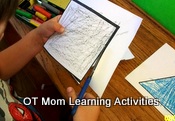 Cutting out a square
Cutting out a square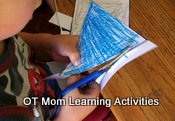 Cutting out a triangle
Cutting out a triangleAgain, cut lots and lots of shapes, be creative with them and use them with lines and circles to make fun crafts. My free cutting activities page has some fun ideas you can use with your kids.
Or try my Fun Cutting Printable Pack for a large variety of cutting printables, including spiral snakes for left- and right-handed children!
Starting with simple snipping activities, the templates will enable your child to learn to cut along the lines for some simple crafts and then to cut out shapes.
All the activities are photographed so you and your child can see what you are working towards!
What If My Child Still Struggles To Cut On A Line?
Sometimes kids can take a little while to learn how to cut along the line. Sometimes they just need to practice one of the underlying skills, like working on hand strength, or on eye-hand coordination.
Below, I have linked to various pages on my site that deal with some of the foundation skills that can help kids learn to cut better.
- If your child's hands tire easily, work on strengthening the hand muscles with some simple activities.
- If your child struggles to coordinate holding the paper and cutting at the same time, then try some bilateral coordination activities.
- You can also try some hand-eye coordination activities to help the eyes focus on the scissor blade and the line and guide the hands in keeping the blade on the line.
- Visual motor integration activities and visual motor worksheets may help your child learn to focus the eyes to guide the hands while cutting.
- If
your child's eyes are watering during scissor cutting activities, or if
your child keeps looking sideways at the paper or closing one eye, PLEASE ask a pediatric or behavioral optometrist to check your child's eyes. This is very important!
- If you want to know more about how to help your child establish a strong foundation for all fine motor skills, then read this page about the essential foundations for fine motor skills.
If your child is still struggling to open and close scissors properly, then take a look at Part 1: Teach Your Child How To Use Scissors.
If your child has mastered cutting on the line, then it is time to progress to Part 3: Simple Cutting Activities To Practice!
And if you want to get all these helpful tips and information, with photographed activities, in an accessible format, then please check out my Scissor Skills E-Book!
Remember, these are only suggestions to
help you guide your child through the developmental stages of cutting.
If you are at all concerned about your
child's progress, please get an occupational therapy evaluation.
Thanks for visiting!
- Home Page
- Scissor Cutting Skills
- Part 2: Teach Your Child To Cut Along A Line
- Home Page
- Preschool Activities
- Part 2: Teach Your Child To Cut Along A Line
Share this page to help others!
Didn't find what you were looking for? Try a search of my site!
